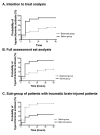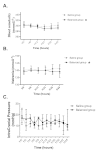Balanced versus chloride-rich solutions for fluid resuscitation in brain-injured patients: a randomised double-blind pilot study
- PMID: 23601796
- PMCID: PMC4057192
- DOI: 10.1186/cc12686
Balanced versus chloride-rich solutions for fluid resuscitation in brain-injured patients: a randomised double-blind pilot study
Abstract
Introduction: We sought to investigate whether the use of balanced solutions reduces the incidence of hyperchloraemic acidosis without increasing the risk for intracranial hypertension in patients with severe brain injury.
Methods: We conducted a single-centre, two-arm, randomised, double-blind, pilot controlled trial in Nantes, France. Patients with severe traumatic brain injury (Glasgow Coma Scale score ≤8) or subarachnoid haemorrhage (World Federation of Neurosurgical Society grade III or higher) who were mechanically ventilated were randomised within the first 12 hours after brain injury to receive either isotonic balanced solutions (crystalloid and hydroxyethyl starch; balanced group) or isotonic sodium chloride solutions (crystalloid and hydroxyethyl starch; saline group) for 48 hours. The primary endpoint was the occurrence of hyperchloraemic metabolic acidosis within 48 hours.
Results: Forty-two patients were included, of whom one patient in each group was excluded (one consent withdrawn and one use of forbidden therapy). Nineteen patients (95%) in the saline group and thirteen (65%) in the balanced group presented with hyperchloraemic acidosis within the first 48 hours (hazard ratio = 0.28, 95% confidence interval [CI] = 0.11 to 0.70; P = 0.006). In the saline group, pH (P = .004) and strong ion deficit (P = 0.047) were lower and chloraemia was higher (P = 0.002) than in the balanced group. Intracranial pressure was not different between the study groups (mean difference 4 mmHg [-1;8]; P = 0.088). Seven patients (35%) in the saline group and eight (40%) in the balanced group developed intracranial hypertension (P = 0.744). Three patients (14%) in the saline group and five (25%) in the balanced group died (P = 0.387).
Conclusions: This study provides evidence that balanced solutions reduce the incidence of hyperchloraemic acidosis in brain-injured patients compared to saline solutions. Even if the study was not powered sufficiently for this endpoint, intracranial pressure did not appear different between groups.
Trial registration: EudraCT 2008-004153-15 and NCT00847977.
Figures




Comment in
-
Is sodium chloride worth its salt?Crit Care. 2013 Jun 11;17(3):150. doi: 10.1186/cc12732. Crit Care. 2013. PMID: 23759127 Free PMC article.
References
Publication types
MeSH terms
Substances
Associated data
LinkOut - more resources
Full Text Sources
Other Literature Sources
Medical

